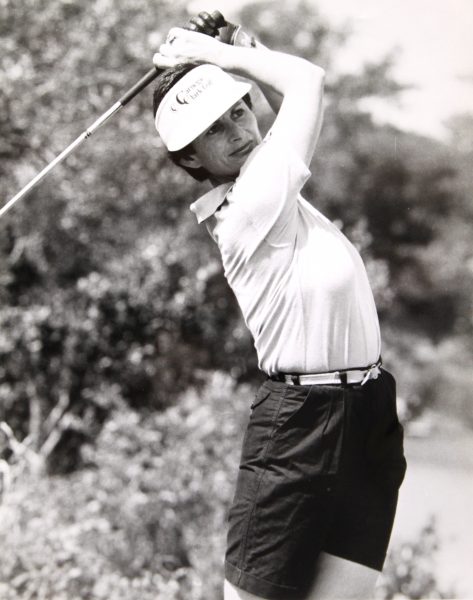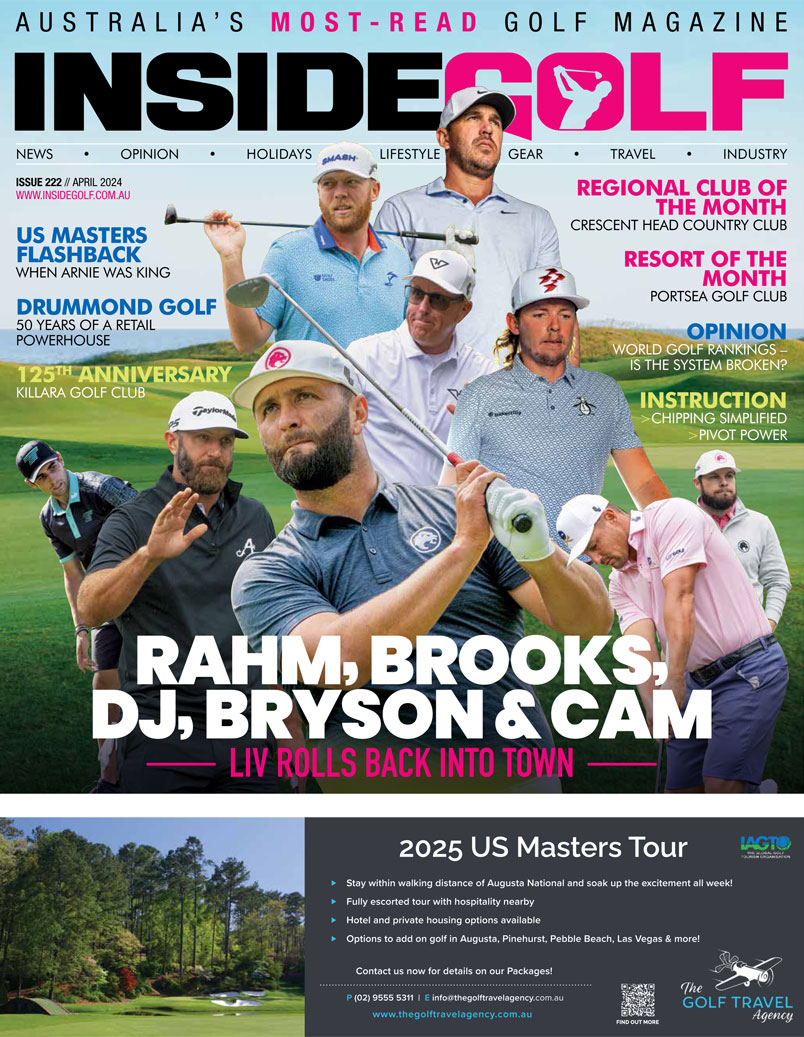
WHEN golf historians blow the dust off the record books and go in search of great Australian golfers they will undoubtedly stop at the letter G and ink in one of the greatest – Lindy Goggin.
Born and raised in Launceston, Tasmania, the extraordinarily talented Lindy stretched a stellar amateur career across four decades.
She enjoyed worldwide success, proudly representing her country with distinction in team events and national championships.
A champion swimmer and water skier, Lindy took up golf aged 10 and her brilliant career took off after she won the 1967 Tasmanian amateur championship.
And, as they say, she was on her way.
She went on to win a further 18 Tasmanian amateur titles – the last in 1991 at the age of 42.
One of Lindy’s most amazing Tasmanian amateur victories was in 1974 – just seven days after leaving hospital following the birth of son Mathew.
“No wonder Mathew became a golfer,” Lindy laughed. “I actually checked myself out of hospital because I knew I had to play the following week.
“My mother was president of the Golf Union at the time and Mathew was in a little basket beside her while she ran the state championship.
“I was very fit when I had Mat so it was pretty easy,” said Lindy, who played and practiced right up until she gave birth.
Titles and course records regularly fell into Lindy’s hands including three Australian amateur championships (1971, ’77 and ’80).
She was runner-up twice in 1972 and 1980, won the national averages six times and represented Australia for 19 years between 1970 and 1988.
She held course records from Brisbane to Perth including Indooroopilly, Lake Karringyup, Royal Melbourne, Royal Adelaide, Royal Hobart and Tasmania Golf Club. Her course record at Royal Hobart was a remarkable 65 – eight-under par.
Lindy’s long game, honed on the fairways of the Lindisfarne club (now Tasmania Golf Club), was her strength.
Pity her opponent when she pulled a four-wood from her bag and took aim at the flagstick.
Inevitably, the ball would finish on the green and oftentimes near the cup.
“The old course was unique because it had a lot of canyons,” Lindy explained. “We lived on the 15th hole which had this huge canyon and my father used to love watching me play four-woods and fairways woods because I would have to hit over this canyon and if didn’t I was in the canyon.
“So, I became a very strong long iron (2, 3, and 4 iron) and four-wood player.”
In 1977, Lindy, perhaps unsurprisingly, embarrassed the professionals when she won the Australian Women’s PGA title by five strokes.
“Jan Stephenson had just turned professional and it was the first ALPG event in Australia,” Lindy recalled.
Lindy went on to captain the Australian team five times.
The team won five Tasman Cups, three Espirito Santo world titles, three Commonwealth Series and Lindy was the leading player at the Queen Sirikit Cup in 1981 and ’82.
“We had a nucleus of good players including Jane Lock, Edwina Kennedy, Jane Crafter, Sandy McCaw and Louise Briers.
Around that time, Lindy played off +4, the lowest handicap in the world, and could have dramatically improved her career record in 1981 when she came within a whisker of winning the US women’s amateur.
She defeated Rosie Jones in the semi-final after staging a back-nine fight back. Four down after 11 holes, Lindy won the next five holes to take the lead, lost the 16th, birdied the 17th to get the lead back and halved the 18th.
“Rosie was on fire and I said to Charlie (husband), who was caddying for me, ‘I can’t best this girl’ but I kept going and ended up beating her,” she said.
In the final, Lindy led Juli Inkster with two holes to play. The American birdied the final two holes from three and four metres respectively to win the title.
“They were long putts, but Juli is an unbelievable player,” Lindy said. “She won again the following year and I reached the semi-final.”
I ask Lindy if she regrets not turning professional after Inkster and Jones joined the play-for-pay ranks and won more than $15 million and $10m respectively.
“Not really because I wasn’t money driven, but I would now if I had my time over again and things are as they are now,” she said.
“If I had turned pro it would have been a different lifestyle – totally.”
What’s perplexing is Lindy didn’t play with the same confidence as her peers, which is something of an oddity, certainly a rarity, for a winner of so many tournaments.
“Look, everybody said I was the best amateur golfer in Australia and I suppose the record speaks for itself, but I didn’t have the confidence in my ability that someone like Jane Lock or Jan Stephenson had,” she revealed.
“If I had Jane or Jan’s confidence, I probably would have won twice as much.
“Yes, I was a good player and had the lowest handicap in the world but I felt I should have won a lot more.”
There is little doubt Lindy would have made a great success as a professional, but she decided to become a part-owner of a thoroughbred racehorse stud with husband Charlie … for many years the leading trainer in Tasmania.
“Charlie followed my golf career for a long time, then Mathew came along and we put a lot of time into him,” she said. “I preferred watching him play rather than play myself.
“Then horses took over and I helped Charlie when we had 60 horses in work.”
A member at Royal Hobart Golf Club, Lindy seldom plays golf, preferring to spend time with her grandchildren.
“I play tennis twice a week, dabble in golf and spend a lot of time with my grandchildren,” she said.
“And I am helping my granddaughter get going in golf at the moment.
“She is 12 and doing well.”
Lindy told Inside Golf she was impressed with the talent possessed by today’s young players.
“I’m gob-smacked by some of the scores these young kids are shooting,” she said.
“The length the kids hit it blows me away.
“The kids are driven and told to go for it. Mathew told me to let Hallie (granddaughter) rip it because if you can’t hit it long you are wasting your time.
“To be a good player today you have to be a big hitter, strong and have a good short game.”
FOOTNOTE: In 1993, Lindy Goggin was made a Member of the Order of Australia for her services to amateur golf.
Stablehand Goggin mucked in
PROFESSIONAL Mathew Goggin certain wasn’t given a “saloon passage” growing up in Tasmania, according to his mother Lindy.
Lindy and husband Charlie own a thoroughbred racehorse stud and young Mathew had to do his fair share of work around the stables before going off to practice his golf.
“For him to play golf, he had to get up early and be at the stables at 6.30 every morning to muck out boxes,” Lindy told Inside Golf.
“That was his pocket money and then he went off to practice.”
“He did that right up until he went overseas.”
Lindy said Mathew did not intend to follow in his father’s footsteps, however, his sister Luella became Charlie’s right-hand woman.
“She is a magician with horses,” Lindy said. “She can do anything and even breaks them in.”




![Win the golfing experience of a lifetime, at the Hawai‘i International Week of Golf, valued at $6,900 [Winner Announced] Win the golfing experience of a lifetime, at the Hawai‘i International Week of Golf, valued at $6,900 [Winner Announced]](https://www.insidegolf.com.au/wp-content/uploads/Hawaii-Comp-500x294.jpg)